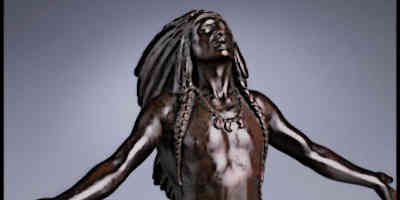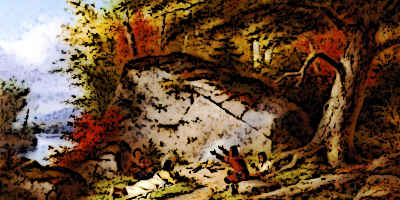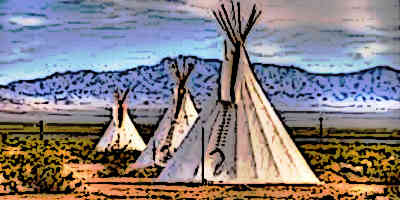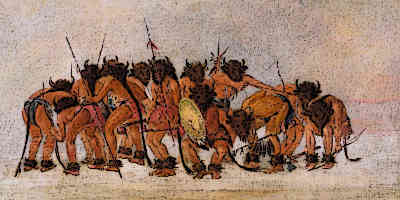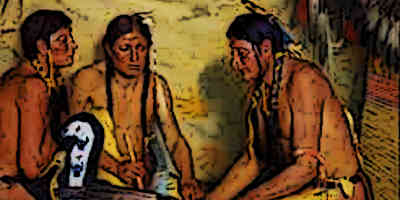Native American Beliefs
Native Americans held a number of beliefs that were unique to their culture, influenced by nature
Native American Culture
The culture of the Native American tribes who lived in the Americas before the arrival of the Europeans
Native American Daily Life
Everyday life of the Native American people comprised of many important tasks and responsibilities
Native American Dance
Native Americans dance on festivals, during ceremonies and rituals, or as a part of various other social occasions
Native American Education
Before the Europeans arrived native American Indians were taught by the tribe elders
Native American Games
Games were a popular form of entertainment among the Native Americans.
Native American Homes
Native American Indians had different types of homes depending upon their lifestyle
Native American Language
It is estimated that more than 2,000 languages were spoken by Native American tribes at one time
Native American Patterns
Native Americans used various forms of art to adorn their rugs, blankets and other textiles
Native American Religion
One of the common aspects of the religion of most Native American tribes is the Great Spirit
Native American Rituals
The Native Indian tribes performed various rituals to appease the gods, celebrate an event
Native American Traditions
Native American Indians traditions and culture was passed from one generation to another.
Native American Words
A large number of Native American words have entered the English vocabulary, see some of the more popular ones
Below is a brief outlook of various aspects of the lifestyle of the Native American tribes:
Native American Rituals
Native American tribes performed various rituals that carried spiritual significance. Most of the rituals were performed to mark different occasions. For instance, some of the rituals were performed as a part of the festivals and ceremonies related to agriculture. Such rituals were usually performed to please the spirits and show respect to them.
Another important ritual was the rite of passage. Boys and girls in most Native Indian tribes were required to pass the rite of passage when they came of age. This usually involved performing a task that was daring or exceptionally hard.
Native American Religion
Different Native American tribes held different beliefs. However, they also had many common ideas when it came to religion. For instance, nearly all tribes believed in the existence of spirits. They believed that there were different spirits which overlooked and protected the men. They also thought that there was a Great Spirit who was the supreme and most powerful deity. Many tribes believed that the Great Spirit had created the world and populated it with men.
Native American Games
Native Americans played a number of games. These games served as a form of entertainment. Most notable among these was a kind of stickball game. In this game, a large number of players tried to hit a ball with their sticks. The ball was almost the size of a tennis ball. The game was played by the male as well as the female members of the tribes.
The stickball played by the Native American tribes was also the origin for the modern-day game of lacrosse. Another kind of game often played by the Native Indians involved hiding sticks under their hands and asking the other team to guess.
Native American Language
Native American tribes spoke a large number of languages. Many of these languages became extinct after Europeans arrived in Americas because large number of Native Americans died due to diseases, warfare and other causes.
It is estimated that in the 15th century, nearly 1500 to 2000 languages were spoken by the Native American tribes. These were categorized into different families including: Wakashan, Salishan and Chimakuan languages; Aztec and Mayan languages; Eskimo-Aleut languages; and Nahuatl among others. Today, Native Americans speak around 300 languages.
Native American Homes
Native Americans lived in a variety of homes depending on their lifestyle and culture. The tribes which relied mainly on hunting usually lived in teepees. These were cone-shaped tents made from buffalo hide. Teepees were easy to erect and quick to dismantle to support the nomadic lifestyle. Other tribes which were more settled lived in more permanent dwellings such as the pueblos and longhouses.
Pueblos were built from adobe clay bricks and were often many stories tall. The Hopi tribe in the southwest of modern-day USA usually built the pueblo dwellings. Longhouses were built by the Iroquois nation. These houses were 80 feet long and nearly 18 feet wide. Each house was home to an entire clan.
Native American Education
Native American tribes didn’t have a formal form of education until the 19th century. The boys and girls were taught about practical work by their respective elders. The boys would start going out with the men at a young age. They would perform different tasks and learn from the men. The girls would assist their mothers in their work in the field as well as the chores they did at home. The children also frequently sat down by the village elders who told stories and taught them about the history and culture of the tribe.
Native American Beliefs
Native Americans held various beliefs that were a part of their spirituality. The most basic of these was the belief in many spirits, the main being the Great Spirit. Many Indian tribes also believed in the existence of three worlds: an Upper world inhabited by the deities and believed to be a perfect place, like heaven; a Lower World or the underworld which was the home of many of the evil things and was not a great place; and this world, which man inhabits.
Native American Food
Native Americans relied on agriculture, hunting and fishing to get their foods. They farmed maize, beans and other crops. Maize was the staple food source and tribes which practiced agriculture and heavily relied on it. Other tribes who primarily relied on hunting would hunt bison and consume bison meat for food. The hunter tribes also hunted other animals such as deer and rabbits.
Towards the western coast, especially in the northwest, Indian tribes relied on fishing as the primary source of meats. They also foraged the forests and trees around them for nuts, berries and other natural foods.
Native American Art
Native Americans practiced various forms of art. They used their art to decorate everyday accessories such as rugs, blankets and clothes. They also depicted art in the form of drawing and paintings. In the eastern regions, Native American tribes frequently created totem poles, which were a unique form of art depicted on a long pole shaped from cedar bark. The medicine men, who were also the spiritual leaders of the tribes, often created art in the form of sand paintings, drawings and masks.
Native American Traditions
A number of important social, cultural and spiritual traditions existed among Native American tribes. Dancing was a popular tradition and acts such as the Sun Dance and the Ghost Dance were performed on specific occasions. Fasting was another tradition which was often practiced by the younger man of a tribe. The young men would fast and traditionally go into the wilderness for several days to seek and find their guardian spirit.
Native American Houses
Native American houses were of different types. The most important include the teepee, the longhouse and the pueblo. The teepee was often used by the hunter tribes who were frequently on the move. The longhouse and the pueblo were more permanent dwellings used by tribes who didn’t move around too often.
Native American Patterns
Native American patterns refer to the style and outlook of the patterns used in the textiles and other accessories made by the Native American tribes. Historically, Native American tribes had adorned the rugs, blankets, clothes and other accessories with their art. The unique style of this art came to be known as the Native American pattern.
Native American Dance
Native American tribes practiced different forms of dances. These dances were often practiced to commune with the spirits or to show respect to them. Some of the dances were specific to certain events while others could be performed at any time by following a definite ritual.
In most cases, a Native American dance was a community event. It was performed in an open field or area with the dancers surrounding by the onlookers. The dances were usually led by an important person, such as the chief of the tribe or the medicine man.
The most popularly known form of Native American dance is the Sun Dance. In this dance, the dancers would move to the sound of drums and other equipment. Some dancers would also smoke tobacco or other herbs. Native Indians hold that the Sun Dance allows them to commune with the sun god or a related deity, and seek the deity’s blessings.
Native American Clothing
Native American clothing typically depended upon the climate of the region in which a tribe lived. It also depended on the materials available to that tribe. Most tribes who hunted animals would make their clothes by using bison hides, deerskin, seal skin or the skin of other animals. The skin was tanned and then processed manually with hands to make clothes.
Other tribes who were more settled and practiced agriculture learned how to make clothes from weaving thread. Such tribes had more refined clothing and also created blankets and other accessories from clothing materials.
Native American Symbols
Symbols were a frequent form of visual communication and art in the Native American culture. The warriors painted their faces and bodies with symbols signifying spiritual power. Tribes in the northeast and northwest used elaborate symbols to adorn their totem poles. Native Indians also used these symbols on their clothes and paintings.
Most of the Native American symbols incorporated natural elements such as animals, trees and rivers as well as the stars, the Sun and the Moon. Some symbols also borrowed from Christianity once the Europeans arrived in the Americas. Symbols were believed to have significant power, which is why warriors used the symbols which they hoped would strengthen and protect them in battle.
Native American Life Great Resources for Further Education
